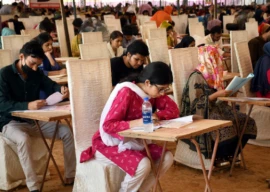
Pakistan has the world’s sixth-largest population but the world’s ninth-largest workforce. The difference between the two positions is because of the relatively lower rate of participation of women in the labour force. According to the Labour Force Survey of 2010-11, the size of the workforce is estimated at 57.24 million or 32.3 per cent of the then population of 177 million. If the participation rate has not changed, the size of the workforce in 2013-14 would be 60.7 million. About six per cent of the workforce, or 3.6 million people, are estimated to be unemployed. Since a significant number of underemployed are counted as working, the number not working full time is much higher than the official unemployment figure.
According to the labour survey for 2010-11, while there was a decline in rural unemployment that in the urban areas increased between 2009-10 and the following year. Punjab has done less well in terms of job creation while Khyber-Pakhtunkhwa saw a decline in the number of people employed. In the latter case, the reason was probably out-migration to other provinces. The province has been contributing service sector workers to the country’s major cities, not only to Karachi which has remained the favoured destination, but also to Lahore and Islamabad. Punjab, with 2.1 million unemployed people, accounts for 58.3 per cent of the people who are out of work. Migration out of the country has provided an outlet for the unemployed as well as those seeking better returns for their labour. In 2013-14, the government estimated that 48 per cent of the workforce working abroad was in the Middle East, 28 per cent in Europe, and 19 per cent in North America. The remaining five per cent was mostly in East Asia.
In the past, Pakistan has experimented with some success with government funded employment generating programmes. During the period of Ayub Khan, rural works programmes were launched in both East and West Pakistan. They were generously funded from the sale of wheat provided free by the United States. Washington’s PL-480 initiative allowed the recipient of the food aid to market the grains received and use the proceeds for the purpose of development. The rural works programme used the local governments that were part of the system of Basic Democracies to implement small schemes suggested by the local councils. The PL-480 funding continued even after the United States suspended its development assistance following the 1965 war with India. The local councils working under the direction of district deputy commissioners were allowed to spend money on building farm-to-market roads, small clinics, schools and markets. The construction work was done using labour-intensive technologies.
However, the fact remains that labour-intensive programmes don’t do much to solve the problem of employment. Job creation in the numbers required by a large and growing population needs relatively high rates of growth and focus on the sectors and labour-using technologies. The work done at the International Monetary Fund suggests that the Pakistani economy needs to grow at a rate of at least seven per cent a year to find jobs for those who are currently unemployed or underemployed as well as those million and a half new entrants every year into the workforce. The economy is neither growing at that rate nor is the government placing emphasis on developing the sectors that can use labour. The focus has been on such capital-intensive development initiatives as motorways and large power plants. For instance, public policy aimed at developing the livestock sector would do a great deal in terms of creating new jobs and providing opportunities for rural women who remain the poorest segment of the population.
Published in The Express Tribune, August 25th, 2014.
Like Opinion & Editorial on Facebook, follow @ETOpEd on Twitter to receive all updates on all our daily pieces.
COMMENTS (3)
Comments are moderated and generally will be posted if they are on-topic and not abusive.
For more information, please see our Comments FAQ











1735025557-0/Untitled-(96)1735025557-0-270x192.webp)







Para 1 states: "I will indicate what can be done by way of economic policies to keep these people off the political street".
Did I miss something?
The premise of this articles was supposed to highlight more key factors that is enabling people to keep on the protest without any daily responsibility. To my own judgement, majority of the people in the protest are students who gather after their university hours. Many people have taken leaves from their offices. Some of the offices in the Red Zone and alike have been closed which also enables the people to join the protest. Alongside, there are people who join the protest after regular intervals say for instance: on weekends, or when there is somebody in their homes to take care of the affairs. Kindly, do give your expert opinion about it as well.
You can't boil the ocean by randomly "creating jobs". PK needs to use cities as centres for a metro economy to catapult rural development into growth mode that will fulfil domestic demand in cities, For that you need advanced linear transport infrastructure, and the energy to move materials on it. There is a lots of waste in the supply chain because markets are not connected to the raw material sources. Cities with their high HDI need to be the export hubs, while rural productivity has to increase to fuel that growth. But for all of this to happen you need a stable government, peace, and continuity of policies, without which milk will go sour, and fruits will rot at the source.